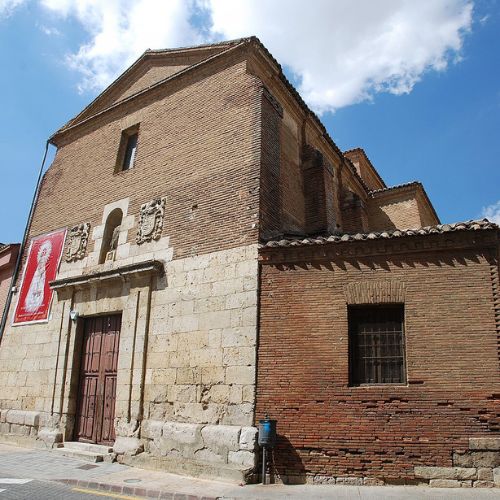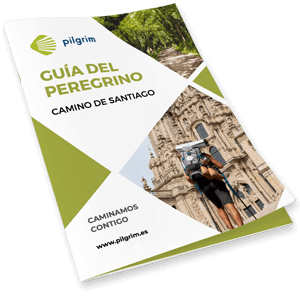Carrión de los Condes
‹ Back to the stage
Carrión de los Condes
- Residents: 2.198 aprox.
- Province: Palencia
Information
Get to know Carrión de los Condes
Carrión de los Condes is a small town that has had a very important past, so much so that it has been home to such important historical figures as the Retes, the Infantes de Carrión and the Marquis of Santillana.
At this end of the stage, pilgrims will find all the services they need.
Location
How to get there
The main way to get to Carrión de los Condes by car is heading to Palencia and from there take the CL-615 and after 40km you will reach the center of town. Another option is to go from Burgos on the A-231 or León on the same road in the opposite direction.
The other alternative could be to get to any of these three major cities (Burgos, Leon and Palencia) either by car, bus or train and go to Carrion de los Condes by bus. From Palencia the company AJA provides the service and offers daily lines with various timetables in both directions. From Burgos the company is ALSA and there is a daily bus that makes the route. From Leon also does this company and also offers a daily bus except on Saturday that there is not.
History / Culture
What to see
Iglesia San Julián
The Church of San Julian has a single nave, with a Latin cross plan and built in brick. It was fully restored in the sixteenth and seventeenth centuries, which allowed to preserve the facade of the late sixteenth century, with two coats of arms and a niche with the carving of St. Julian in wood on a pedestal on which you can read: “ANGEL DE BERRIO PATRONO DE S. JULIAN”.
The interior is covered by a barrel vault with lunettes and a dome over the transept, on the sides of which were placed the arms of the Marquis of Villasante. We also find the best set of baroque altarpieces of the town with sculptures made by Pedro del Mazo Vélez in 1706.

Casa del Águila
The Casa del Águila is considered a palace-house, which belonged to the Velasco family. It was the birthplace of Don Luis de Velasco, second viceroy of New Spain and his son, who became viceroy of Peru and New Spain.
It was one of the oldest civil buildings in the city, but because it remained closed and neglected for many years, it was completely destroyed, with the exception of the facade, in 1999 in order to rebuild it from scratch.

Puente Mayor
The main bridge has seven spans built in ashlar stone and compacted blocks of lime, sand and stone. There is also documentation that indicates that it was provided with fortified doors at its ends, but only endured until the second half of the sixteenth century, when it was demolished.

Ermita de la Piedad
The Ermita de la Piedad is located in the vicinity of the Monastery of Santa Clara, being the first temple that all pilgrims encounter at the entrance of Carrión de los Condes.
The stone chevet is Gothic in style, while the rest of the building is made of brick. This hermitage was rebuilt under the patronage of the abbess Sister Luisa de la Ascensión in 1625, as indicated by an inscription that can be read on the ceiling of the same. It is also recorded that it was renovated in the nineteenth century, but since 1993 what remains is exposed in the Church of Santiago.

Real Monasterio de San Zoilo
The Royal Monastery of San Zoilo was declared an Asset of Cultural Interest (BIC) on July 11, 2002.
The monastery had various uses over time, first as a religious and political center of the first order, then as a residence of kings and in the Middle Ages it was used as a pilgrimage center.
<pAt the beginning of the 19th century, the monastery was affected by several processes of disentailment and exclaustration, so in 1954 it was converted into a Diocesan Minor Seminary until 1986. Subsequently, in 1992, the Diocese sold the property, reserving the ownership of the monumental part, although a large hotel complex was installed in the building.
During the refurbishment of the hotel complex, a Romanesque doorway dating from the 11th and 12th centuries was discovered in the Galilean room, which had remained walled up since the construction of the present church in the 16th and 17th centuries. This is the reason why the state of conservation is excellent.

Museo de Santiago
The Museum of Sacred Art is also known as the Museum of Santiago, since it has been located inside the church of Santiago since 1993. In this space are preserved pieces from the artistic funds of the parish of Santa Maria, the Church of Santiago itself and the hermitages of San Juan de Cestillos and La Piedad.
It also collects other objects from the defunct parish church of San Juan del Mercado and the extinct monasteries of San Francisco and Santa Isabel, as well as other donations from a neighbor of the area, such as pieces of goldsmithery, cantorales, lecterns, paintings, sculptures, etc.
.

Monasterio de San Francisco
The Monastery of San Francisco de Carrión de los Condes was founded at the beginning of the 13th century. Years later, after the effects of the War of Independence (1811) and the disentailment of the monastery, it was abandoned due to its poor condition, but in 1971 Daniel Álvarez de Bobadilla acquired the remains.
<pAt present the little that remains of the monastery is in the museum of the Monastery of Santa Clara, such as the work of San Pedro Regalado, San Antonio de Padua, San Diego de Alcalá, the Virgin of the Angels, San Luis Obispo and San Cristóbal.

La Inmaculada Concepción
The Image of the Immaculate Conception is placed in the Plaza de Santa Maria, completing the renovations of the Plaza in 1971-1972. The Image dating from 1905 is made of iron, imitating the statue that is in the Plaza of Spain in Rome.
Recently works have been carried out in the square and the opportunity was taken to restore the iron statue, cleaning it to subsequently treat the oxidation and then protect it with an anti-humidity varnish.

Iglesia de Santiago
The church of Santiago de Carrión de los Condes, built in the 12th century, was declared an Asset of Cultural Interest.
The western facade of the temple stands out especially as it is formed by a semicircular arched doorway with a figured archivolt in which the medieval trades of Carrión appear. The facade is striking because it has 24 figures, 22 human and 2 lions, these are represented from left to right.

Iglesia de Santa María del Camino
The church of Santa María del Camino has a Romanesque style. It was built in the mid-twelfth century with three naves of four sections, being the widest the central one, with two apses and a transept that protrudes in height, besides having a bell tower at the foot of the church.
It is dedicated to the Virgin of Victories in allusion to the defeat suffered by the Muslims, when they came to Carrion to collect the “Tribute of the Hundred Maidens”. The Christians of King Mauregato had to pay Miramamolín with one hundred girls, and Carrión had to deliver four of them. On leaving the town, the girls begged to say goodbye to the Virgin and this, on hearing their prayers, made four bulls appear, which caused the Muslims to flee, leaving the girls free.

Iglesia de Santa Clara
The Church of Santa Clara arose between 1614 and 1621 from the union of a very humble primitive church of the monastery with that of the Holy Spirit of the Augustinian Regulars, resulting in a church of classical Renaissance style.
The Church of Santa Clara was built between 1614 and 1621.
The Abbess Sister Luisa de la Ascensión Colmenares built it thanks to a donation from Philip III (1598-1621) and the rents granted by Philip IV (1621-1665), as well as gifts from the wives of both in gratitude for the good advice and prayers of the latter. The temple is of ashlar masonry and the church consists of a single nave, with a barrel vault with lunettes and dome in the transept with flat plasterwork and several small chapels with niches.

Museo de Santa Clara
The Santa Clara Museum was inaugurated on April 4, 1987, but a few years later, in 1993, it was expanded by adding another room. In 2002 a second expansion was carried out incorporating new showcases, paintings, sculptures and other objects, as well as a collection of coins and a collection of nativity scenes from all over the world.
<pThe museum exhibits pieces from the monastery of Santa Clara and former convents such as Santa Isabel (now disappeared) and San Francisco (disappeared), we will also find other pieces that were donated or acquired by the community.
As a curiosity it is worth noting that inside the museum, from December to February, there is a collection of cribs started in the twentieth century by Sister Maria Micaela Velon de Francisco. Right now there are more than a hundred cribs made of all kinds of materials, from all over the world and from all eras.

Casa de los Girón
The Casa de los Girón is a spectacular 18th century building and one of the few buildings that survived the fire that occurred in 1811, during the War of Independence.
On the facade, built in ashlar and brick, are sculpted family coats of arms and its windows have a magnificent grille.
In the interior, just behind the front, a small hall leads to a beautiful courtyard with Doric columns. Here are located the stairs up, which are decorated with portraits of some kings and queens, the family coat of arms and an image of the Immaculate Conception.

Casa del Marqués de Santillana
The house of the Marquis of Santillana presents on its facade a Mendoza family coat of arms, which reads “Ave Maria, gratia plena” and a stone arcade made on the occasion of the VI Centenary of his birth.
The interior of the house has been altered over the centuries by successive refurbishment works as a family home. In this house was born D. Iñigo Lopez de Mendoza and therefore it is in this place where he learns to love literature and philosophy.

Iglesia de Nuestra Señora de Belén
The Church of Our Lady of Bethlehem of Carrión de los Condes is a Catholic temple located in the highest part of the town and overlooks a cleft opened by the Carrión River, from which you can see the entire Carrión riverbank.
The church was built between 1552 and 1579 on a primitive medieval temple of the late fifteenth century. Later in the 17th century, a remodeling was carried out in which the orientation of the church was changed, a new nave was built and the tower was finished.
In the interior, the main altarpiece stands out, in the Plateresque Renaissance style, from the early 16th century.

Casa de la Cultura
The Casa de la Cultura dates back to 1568 and is located behind the Town Hall. From its construction to the present day the building had several uses, such as jail and courthouse.
At the end of the twentieth century it was repaired as the House of Culture and Municipal Library, although it is the reform of 2005 that is responsible for the current appearance. Of the primitive construction is preserved the first body of the stone facade, with two coats of arms of the royal arms and the City. On the first floor was where the dungeons and prison cells were located, which are now used as offices and meeting rooms
.
In 2012 the building was renamed the Fray Miguel de Benavides Library (1552-1605), in honor of the Dominican friar who founded the University of Manila.

Casa de la Calle Padre Gil
The Casa de la Calle Padre Gil is considered to be the oldest house in this town, dating from approximately the end of the 15th century. At present it still preserves, as a sign of its most splendid past, a coat of arms and the top of the final parts of what may have been an alfiz.
On the same facade there is a coat of arms with a vase full of lilies, a Marian style present in some religious buildings in Carrión de los Condes, representing the purity of Mary.
The coat of arms has a lily vase, a Marian style present in some religious buildings in Carrión de los Condes, representing the purity of Mary.

Iglesia de San Andrés Apóstol
The Church of San Andrés Apóstol is known as the “Cathedral of Carrión de los Condes”, which is located north of the town, in the square of the same name. It was built over the previous church in ashlar stone, finishing the work in 1574.
The original tower burned down during the War of Independence, so it was restored in brick and stone, with octagonal dome and crowned with lantern and stone cross, according to a project of 1866.
The original tower was burned down during the War of Independence, so it was restored in brick and stone, with octagonal dome and crowned with lantern and stone cross, according to a project of 1866.

Convento Hijas de la Caridad
The Hijas de la Caridad Convent was occupied by the daughters of St. Vincent de Paul when they received an inheritance in approximately 1894. The convent is located at the back of the site of the Palace of the Counts of Salinas de Pisuerga and was dedicated to the education of the girls of Carrión de los Condes.
In 1957, after suffering a fire, it was rebuilt and continued to serve as a school until 2002. From this date it is reformed conditioning part of the convent as a hostel for pilgrims, with access through the central courtyard. The other part of the convent is also enabled to accommodate retired nuns, who are responsible for managing the hostel and help in pastoral work in Carrión and in the region.
The convent consists of an oratory for the community and a neo-Gothic style church, currently without worship. In the presbytery are buried the remains of those benefactors who donated their inheritance to the Daughters of St. Vincent.

Convento de la Santísima Trinidad
The Convent of the Holy Trinity is the most modern of Carrión, since its construction dates back only to 1974, after the previous one burned down. It was designed by the architect Carlos Rivera, and consists of the church, the lathe, the parlor, the refectory, the infirmary, the upper and lower choirs, the chapter house, the recreation room and the nuns’ cells.
Brick was the material used for the construction of the church and it is decorated by a Crucifix and a Virgin of Carmen, works made in wood by the sculptor Victor de los Rios. Inside the church you can also see several paintings from the seventeenth century depicting scenes from the life of St. Teresa.
<p
San Julián de Cestillos
The hermitage of San Julián de Cestillos has a structure of a single nave with a barrel vault roof and the sacristy attached next to the gospel. Under the sacristy we see the beginning of a low tower with a single bell.
The last reconstruction that the hermitage underwent dates from 1740 and was carried out by the Carrioneses master builders José Iglesias and Eugenio Rodríguez.
Until 1994 the chapel contained an altarpiece from 1600 in honor of St. John the Baptist, in that year it was transferred to the museum of the church of Santiago.
<p
Real Monasterio de Santa Clara
The Royal Monastery of Santa Clara was founded in 1231 by two disciples of Saint Clare. It is therefore one of the oldest Poor Clare monasteries in Spain. Throughout the Middle Ages the monastery was closely linked to the Castañeda family so much so that the abbess of the monastery became Dª Beatriz Manrique.
The temple has a Mudejar style typical of the thirteenth and fourteenth centuries, but was not completed until the seventeenth century, a time when the monastery reached great importance thanks to Sister Luisa de la Ascensión.

Information of interest
Local police
979 880 259
Civil guard
979 880 003
Fire department
979 918 200
Civil protection
112
Town hall
979 880 259
Health center
979 880 245
Tourism office
979 880 931
C/ Santa María, s/n

We send you your itinerary
Enter your details and receive your travel itinerary by email
Recommended
Gastronomy
Recommended
Festivals and Pilgrimages
Local festivity
24 de junio: Romería de San Juan de Cestillos
Local festivity
8 de septiembre: Fiesta de Nuestra Señora de Belén
Local festivity
Último lunes de agosto: Fiesta de San Zoilo
Local festivity
3 de febrero: Fiesta de San Blas
Local festivity
5 de febrero: Fiesta de Santa Águeda
Local festivity
7 de junio: Festividad de Corpus Christi
Local festivity
25 de junio: Fiesta de Santiago Apóstol
French Way
On foot
33 stages



































